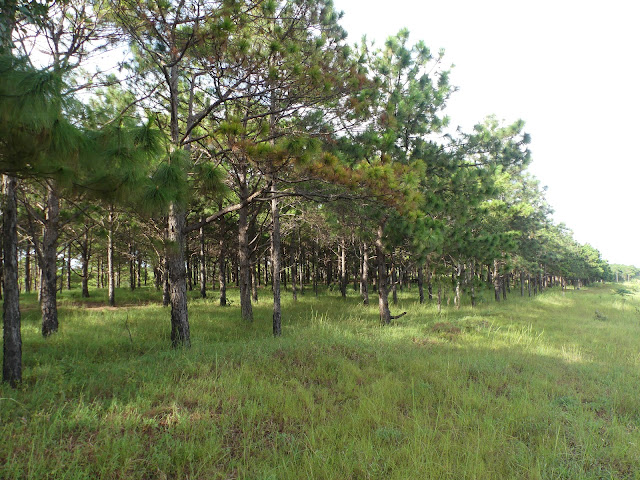Pine trees (Pinus), a significant genus within the coniferous family, are distributed widely across the globe and play a crucial role in both the environment and human industries. Known for their long, slender needles, cones, and aromatic wood, pine species are important in ecosystems, forestry, and a variety of industries. This article explores the origin, significance, and global distribution of pine trees, as well as identifying the countries where they are most prevalent.
Overview of Pine Trees
Pines belong to the genus Pinus, which includes over
100 species of coniferous trees and shrubs. These trees are typically found in
temperate regions of the Northern Hemisphere, though some species are also
present in subtropical and even tropical areas. Pine trees are characterized by
their long, needle-like leaves grouped in bundles, their cones, and their
resin-producing capabilities.
Pines have existed for millions of years, with fossil
evidence dating back over 150 million years to the Mesozoic Era. This long
evolutionary history makes them one of the oldest and most widespread tree
species in the world.
Origin and Distribution of Pine Trees
Pine trees are native to a wide range of regions in the
Northern Hemisphere. They thrive in areas with well-drained soils, sufficient
sunlight, and often endure harsh climatic conditions, such as cold winters and
dry summers. While many pine species are found in temperate climates, some,
such as the Eastern White Pine (Pinus strobus) and the Scots Pine (Pinus
sylvestris), also grow in colder, more northerly regions.
Pine trees can be found in North America, Europe, Asia, and
parts of the Southern Hemisphere, where they have been planted for timber and
reforestation purposes.
Importance of Pine Trees
Pine trees are of immense ecological and economic
significance. Their roles include:
- Ecological
Importance:
- Habitat
for Wildlife: Pine forests provide critical habitats for various
species of birds, mammals, insects, and other organisms. For example,
pine nuts (from species like the Pinon Pine) are a food source for
wildlife, and certain birds, such as woodpeckers, rely on pine forests
for nesting and feeding.
- Soil
Stabilization: Pine trees help prevent soil erosion by stabilizing
the soil with their extensive root systems, particularly in mountainous
and coastal regions.
- Carbon
Sequestration: Like all trees, pines absorb carbon dioxide from the
atmosphere, playing a role in combating climate change by storing carbon
in their biomass.
- Economic
Importance:
- Timber
and Construction: Pine wood is widely used in the timber industry due
to its strength, durability, and relative ease of processing. It is a
preferred material for construction, furniture, and paper production.
- Pine
Resin: Pine resin, which is harvested from the tree’s sap, is used to
make turpentine, rosin, and other chemical products.
- Pine
Oil: Extracted from the needles, pine oil has been used in
traditional medicine, cleaning products, and aromatherapy.
- Cultural
Significance:
- Pine
trees have symbolic value in various cultures. In East Asia, for example,
the pine tree represents endurance and longevity, and it is frequently
featured in traditional art, literature, and religious symbolism.
Which Countries Have Pine Trees?
Pine trees are found in a wide range of countries and
regions across the globe. Some of the countries with significant pine tree
populations include:
- North
America: The United States and Canada are home to several important
pine species, such as the Ponderosa Pine (Pinus ponderosa) and
Eastern White Pine (Pinus strobus). Pine forests in these regions
are essential for the timber and paper industries.
- Europe:
The vast forests of Russia, Sweden, Finland, and Norway are dominated by
the Scots Pine (Pinus sylvestris), which is one of the most widely
distributed pine species in the world.
- Asia:
Countries such as China, Japan, and South Korea have abundant pine
forests. The Japanese Black Pine (Pinus thunbergii) and the Chinese
Red Pine (Pinus tabulaeformis) are examples of prominent species in
this region.
- Oceania:
Australia and New Zealand have large plantations of non-native pine
species, such as Pinus radiata (Monterey Pine), which are
extensively used in commercial forestry.
Which Country Has the Most Pine?
Russia is the country with the largest area of pine forests
in the world. The vast expanses of the Russian taiga, particularly in the
Siberian region, are dominated by the Scots Pine (Pinus sylvestris).
Russia's forests, which make up approximately 20% of the world's total forest
area, are a significant source of pine wood for the global timber industry.
Other countries with extensive pine forests include:
- Canada:
Known for its Boreal forests, which cover much of the country and include
a variety of pine species, such as the Jack Pine (Pinus banksiana).
- United
States: Particularly in the southeastern and western regions, the U.S.
has significant pine populations, including species like the Longleaf Pine
(Pinus palustris) and the Ponderosa Pine.
- Sweden
and Finland: These countries are home to large expanses of Scots Pine
forests, which are essential to their forestry economies.
Sources of Information
The information provided in this article is based on widely
accepted knowledge from various sources, including:
- Scientific
Journals: Research articles published in peer-reviewed journals such
as Forest Ecology and Management, Journal of Forestry, and Ecology
provide in-depth analyses on the distribution, ecological importance, and
commercial uses of pine trees.
- Forestry
Textbooks and Botany Resources: Books such as Forest Trees of the
Pacific Northwest and The Gymnosperms provide detailed accounts
of pine species, their characteristics, and roles in ecosystems.
- Environmental
and Forestry Organizations: Reports from organizations like the Food
and Agriculture Organization (FAO) and the World Wildlife Fund (WWF) offer
comprehensive data on global forest cover, including information on pine
forests.
In summary, pine trees are essential to both natural
ecosystems and human economies. They play a key role in biodiversity, carbon
sequestration, and forest industries, while also holding symbolic significance
in various cultures. The largest concentrations of pine trees are found in
Russia, followed by countries like Canada, the United States, and Sweden.






